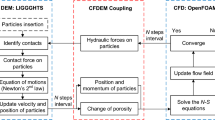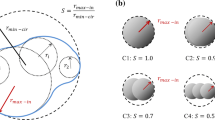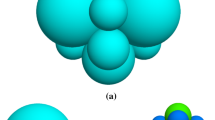Abstract
By quantifying the evolution of void ratio in granular soils of different angularity under different normal stress levels adjacent to geomembranes of varying roughness at different stages of shearing, the effect of geomembrane surface roughness on the interface shear mechanisms between granular materials and geomembranes was investigated. The extent of the shear zone thickness at the interfaces between combinations of round/angular particles and smooth/textured geomembrane surfaces were evaluated. For smooth geomembranes, the interface shear strength is developed by sliding and plowing of sand particles, while for textured geomembranes, the strength results from the interlocking and dilation of sand particles. Study on the effect of particle angularity showed that more angular sand particles resulted in larger plowing effects with smooth geomembranes which in turn yielded higher residual friction angles than with rounded to sub-rounded sand. Higher normal stress produced larger plowing effects for a given sand sheared against a smooth geomembrane and reduced the amount of dilation adjacent to textured geomembranes.
Similar content being viewed by others
References
DeJong, J. T., Frost, J. D., and Cargill, P. E. (2001). “Effect of surface texturing on CPT friction sleeve measurements.” Journal of Geotechnical and Geoenvironmental Engineering, ASCE, Vol. 127, No. 2, pp. 158–168.
DeJong, J. T., Frost, J. D., and Sacs, M. (2000). “Relating quantitative measures of surface roughness and hardness to geomaterial interface strength.” Proceedings of Geo-Eng 2000 Conference, Sydney, CDROM.
Dove, J. E. (1996). Particle-geomembrane interface strength behavior as influenced by surface topography, PhD Thesis, Georgia Institute of Technology, Atlanta, USA.
Dove, J. E. and Frost, J. D. (1996). “A method for estimating geomembrane surface roughness.” Geosynthetics International, Vol. 3, No. 3, pp. 369–392.
Dove, J. E. and Frost, J. D. (1999). “Peak friction behavior of geomembrane-particle interfaces.” Journal of Geotechnical and Geoenvironmental Engineering, Vol. 125, No. 7, pp. 544–555.
Dove, J. E., Frost, J. D., Han, J., and Bachus, R. C. (1997). “The influence of geomembrane surface roughness on interface strength.” Proceedings of Geosynthetics ’97, Vol. 2, pp. 863–876.
Frost, J. D. and DeJong, J. T. (2005). “In-situ assessment of role of surface roughness on interface response.” Journal of Geotechnical and Geoenvironmental Engineering, ASCE, Vol. 131, No. 4, pp. 498–511.
Frost, J. D., DeJong, J. T., and Recalde, M. (2002b). “Shear failure behavior at granular-continuum interfaces.” Engineering Fracture Mechanics, Vol. 69, No. 17, pp. 2029–2048.
Frost, J. D., Evans, T. M., Hebeler, G. L., and Giroud, J. P. (2002a). “Influence of wear mechanisms on geosynthetic interface strengths.” Proceedings of 7th International Conference on Geosynthetics, Nice, Vol. 4, pp. 1325–1328.
Frost, J. D. and Han, J. (1999). “Behavior of interfaces between fiberreinforced polymers and sands.” ASCE Journal of Geotechnical and Geoenvironmental Engineering, Vol. 125, No. 8, pp. 633–640.
Frost, J. D., Hebeler, G. L., Evans, T. M., and DeJong, J. T. (2004). “Interface behavior of granular soils.” Proceedings of Earth and Space 2004 Conference, Houston, pp. 65–72.
Frost, J. D. and Jang, D. J. (2000). “Evolution of sand microstructure during shear.” ASCE Journal of Geotechnical and Geoenvironmental Engineering, Vol. 126, No. 2, pp. 116–130.
Frost, J. D., Lee, S. W., and Cargill, P. E. (1999). “The evolution of sand structure adjacent to geomembranes.” Proceedings of Geosynthetics ’99 Conference, Vol. 1, pp. 559–573.
Fuggle, A. R. and Frost, J. D. (2010). “Particle size effects in interface shear behavior and geomembrane wear.” Proceedings of International Symposium on Characterization and Behavior of Interfaces, Atlanta, IOS Press, pp. 51–57.
Iscimen, M. and Frost, J. D. (2010). “Shearing behavior of curved surfaces.” Proceedings of International Symposium on Characterization and Behavior of Interfaces, Atlanta, IOS Press, pp. 35–43.
Jang, D. J., Frost, J. D., and Park, J. Y. (1999). “Preparation of epoxy impregnated sand coupons for image analysis.” Geotechnical Testing Journal, GTJODJ, Vol. 22, No. 2, pp. 147–158.
Kim, D. and Frost, J. D. (2010a). “Device for constrained/unconstrained testing of geosynthetic interface shear behavior.” Geotextiles and Geomembranes (in review).
Kim, D. and Frost, J. D. (2010b). “Effect of geotextile strain on geotextile-geomembrane interface shear mechanisms.” Geosynthetics Internationals (in review).
Kishida, H. and Uesugi, M. (1987). “Tests of the interface between sand and steel in the simple shear apparatus.” Geotechnique, Vol. 37, No. 1, pp. 45–52.
Lee, K. L. and Seed, H. B. (1967). “Drained strength characteristics of sands.” Journal of the Soil Mechanics and Foundations Division, ASCE, Vol. 93, No. 6, pp. 117–141.
Lee, S. W. (1998). Evolution of sand structure adjacent to interfaces, PhD Thesis, Georgia Institute of Technology, Atlanta, USA.
Lee, S. W., Frost, J. D., and Righter, G. K. (1998). “The influence of geomembrane surface roughness on geomembrane-geotextile interface strength.” Proceedings of Sixth International Conference on Geosynthetics, Vol. 1, pp. 433–438.
Paikowsky, S. G., Player, C. P., and Connors, P. J. (1995). “Dual interface apparatus for testing unrestricted friction of soil along solid surfaces.” Geotechnical Testing Journal, ASTM, Vol. 18, No. 2, pp. 168–193.
Park, J. Y. (1999). A critical assessment of moist tamping and its effect on the initial and evolving structure of dilatant triaxial specimens, PhD Thesis, Georgia Institute of Technology, Atlanta, USA.
Stark, T. D., Williamson, T. A., and Eid, H. T. (1996). “HDPE geomembrane/ geotextile interface shear strength.” Journal of Geotechnical Engineering, ASCE, Vol. 122, No. 3, pp. 197–203.
Ward, H. C. (1982). Profile characterization, chapter 4, in rough surfaces, Thomas, T. R. (ed.), Longman, London, UK.
Zettler, T. E., Frost, J. D., and DeJong, J. T. (2000). “Shear-induced changes in smooth HDPE geomembrane surface topography.” Geosynthetics International, Vol. 7, No. 3, pp. 243–267.
Author information
Authors and Affiliations
Corresponding author
Rights and permissions
About this article
Cite this article
David Frost, J., Kim, D. & Lee, SW. Microscale geomembrane-granular material interactions. KSCE J Civ Eng 16, 79–92 (2012). https://doi.org/10.1007/s12205-012-1476-x
Received:
Accepted:
Published:
Issue Date:
DOI: https://doi.org/10.1007/s12205-012-1476-x




